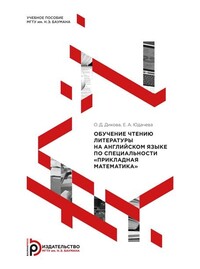Обучение чтению литературы на английском языке по специальности «Прикладная математика»
Покупка
Тематика:
Английский язык
Год издания: 2015
Кол-во страниц: 48
Дополнительно
Вид издания:
Учебное пособие
Уровень образования:
ВО - Бакалавриат
ISBN: 978-5-7038-4198-3
Артикул: 840473.01.99
Учебное пособие состоит из трех уроков и содержит современные неадаптированные тексты, заимствованные из оригинальных источников, о сущности прикладной математики как науки и ее связях с другими науками. Каждый из уроков включает базовый текст А, упражнения на контроль понимания текстов, подбор активной лексики, перевод с русского на английский язык, умение читать математические формулы, а также дополнительные тексты
для различных видов работ с ними. Грамматические упражнения стимулируют повторение наиболее сложных грамматических конструкций. В Приложении приведен перечень основных математических символов и формул, а также даны варианты правильного их прочтения на английском языке. Для студентов старших курсов факультета «Фундаментальные науки», обучающихся по специальности «Прикладная математика».
Тематика:
ББК:
УДК:
ОКСО:
- ВО - Бакалавриат
- 01.03.04: Прикладная математика
- 02.03.02: Фундаментальная информатика и информационные технологии
ГРНТИ:
Скопировать запись
Фрагмент текстового слоя документа размещен для индексирующих роботов
Московский государственный технический университет имени Н.Э. Баумана О.Д. Дикова, Е.А. Юдачева Обучение чтению литературы на английском языке по специальности «Прикладная математика» Учебное пособие
УДК 802.0
ББК 81.2 Англ-923
Д45
Издание доступно в электронном виде на портале ebooks.bmstu.ru
по адресу: http://ebooks.bmstu.ru/catalog/238/book1233.html
Факультет «Лингвистика»
Кафедра «Английский язык
для приборостроительных специальностей»
Рекомендовано Редакционно-издательским советом
МГТУ им. Н.Э. Баумана в качестве учебного пособия
Дикова, О. Д.
Обучение чтению литературы на английском языке по
специальности «Прикладная математика» : учебное пособие /
О. Д. Дикова, Е. А. Юдачева. — Москва : Издательство
МГТУ им. Н. Э. Баумана, 2015. — 47, [1] с.
ISBN 978-5-7038-4198-3
Учебное пособие состоит из трех уроков и содержит современные неадаптированные тексты, заимствованные из оригинальных источников, о сущности прикладной математики как науки
и ее связях с другими науками. Каждый из уроков включает базовый текст А, упражнения на контроль понимания текстов, подбор
активной лексики, перевод с русского на английский язык, умение
читать математические формулы, а также дополнительные тексты
для различных видов работ с ними. Грамматические упражнения
стимулируют повторение наиболее сложных грамматических конструкций. В Приложении приведен перечень основных математических символов и формул, а также даны варианты правильного
их прочтения на английском языке.
Для студентов старших курсов факультета «Фундаментальные
науки», обучающихся по специальности «Прикладная математика».
УДК 802.0
ББК 81.2 Англ-923
МГТУ им. Н.Э. Баумана, 2015
Оформление. Издательство
ISBN 978-5-7038-4198-3
МГТУ им. Н.Э. Баумана, 2015
Д45
ПРЕДИСЛОВИЕ Целью учебного пособия является развитие у студентов старших курсов, обучающихся по специальности «Прикладная математика», навыков работы с оригинальной научной литературой на английском языке, а также точного понимания и грамотного перевода текстов, ведения беседы по основным темам, затронутым в пособии. Задания по переводу с русского языка на английский направлены на повторение и закрепление терминологии по специальности, на использование необходимого грамматического аппара- та. Задания на прочтение математических формул позволят студентам получить достаточный навык изложения материала, содержащего математический аппарат, на английском языке. Грамматические упражнения направлены на повторение наиболее сложных конструкций английского языка. Владение терминологией по изучаемой специальности и языковыми оборотами английского языка, навыки понимания и перевода оригинальной литературы позволят студентам легче ориентироваться в потоке публикаций по специальности на английском языке, определять степень важности получаемой информации для собственной сферы деятельности, принимать участие в обсуждении профессиональных вопросов с зарубежными коллегами.
Unit 1 Texts: A. Pure and Applied Mathematics B. Why is the World Mathematical? C. Mathematics and Physics D. Revolution in Mathematics E. “Queen of Sciences” F. Experimental Mathematics Preliminary exercises I. Translate the following words and determine what part of speech they are. Explain your opinion. Find them in the text: National, international, nation, nationality, nationalism, nationalist, nationally; discuss, discusser, discussible, discussion; approximately, approximation, approximate; solve, solvent, solvable, solver; application, applicator, applicant, apply, appliancy, applicability, applied, appliance; extremely, extreme, extremeness, extremism, extremist, extremity; intractable, tract, tractable, tractate; essential, essence, essentially, essay; heavily, heavy, heaviness; mathematicians, mathematics, mathematical, math; probabilists, probable, probability; correctly, correct, correction, incorrect, incorrectly, correctness; joining, join, joint, jointless, jointly, joined; partition, part, particle, partial, partner, partly; loft, loftiness, loftily, lofty. II. Read Text A and find equivalent phrases in the right-hand column. Find them in the text: 1) строгость и доказательства a) solvable problem
2) начальные и граничные значения b) sloppy crackpot 3) теоретическая и прикладная математика отдаляются друг от друга c) to immerse oneself completely in the subject 4) глубокое понимание предмета d) joining of hands of people 5) индуктивный метод e) initial and boundary values 6) разрешимая задача f) living and breathing the subject 7) полностью погрузиться в тему g) pure and applied mathematics are drifting apart 8) необходимые качества h) inductive method 9) объединенные усилия людей i) rigor and proofs 10) неграмотный чудак j) requisite qualities III. Memorize the following basic vocabulary and terminology to Text A: pure mathematics — чистая математика applied mathematics — прикладная математика boundary value — граничное значение boundary value problem — краевая задача approximate solution — приближённое решение exact problem — строгая задача solvable problem — разрешимая задача intractable problem — трудноразрешимая задача initial value problem — задача Коши, задача с начальными условиями recognize the need — признавать необходимость Text A Pure and Applied Mathematics Toward the end of the recent International Congress of Mathematicians in Madrid, there was a discussion about whether pure and applied mathematics are drifting apart. The majority of the audience was pure mathematicians. So perhaps it would be helpful to ask, what is applied mathematics? A very good answer was provided by Kurt Friedrichs, who distinguished himself in both pure and applied mathematics, “Applied math


